
HMAS Psyche was a Pelorus-class protected cruiser built for the Royal Navy at the end of the 19th century. Initially operating on the North America and West Indies Station, the cruiser was transferred to the Australian Squadron in 1903, and remained there until the Royal Australian Navy (RAN) took over responsibility in 1913. After a stint in New Zealand waters and involvement in the Occupation of German Samoa, Psyche was paid off in 1915.

HMS Mildura was a Pearl-class cruiser built for the Royal Navy in the late 1880s. Originally named HMS Pelorus, she was renamed after an Australian town in April 1890. Per the Imperial Defense Act of 1887, she served primarily in Australian waters.

HMS Royal Arthur was a first class cruiser of the Edgar class, previously named Centaur, but renamed in 1890 prior to launching. She served on the Australia Station and briefly on the North America and West Indies Station before returning to the Home Fleet in 1906. She was paid off after the First World War.
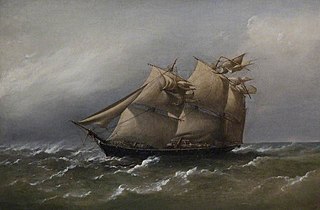
HMS Fawn was a Royal Navy 17-gun Cruizer-class sloop launched in 1856. She served on the Australia, North America and Pacific stations before being converted to a survey ship in 1876. She was sold and broken up in 1884.

HMS Salamander was one of the initial steam powered vessels built for the Royal Navy. On 10 January 1831 the First Sea Lord gave orders that four paddle vessels be built to competitive designs. The vessels were to be powered by Maudslay, Son & Field steam engines, carry a schooner rig and mount one or two 10-inch shell guns. Initially classed simply as a steam vessel (SV), she was re-classed as a second-class steam sloop when that categorization was introduced on 31 May 1844. Designed by Joseph Seaton, the Master Shipwright of Sheerness, she was initially slated to be built in Portsmouth, and was changed to Sheerness Dockyard. She was launched and completed in 1832, took part in the Second Anglo-Burmese War and was broken up in 1883.
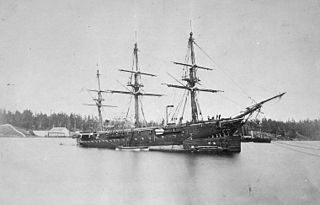
HMS Charybdis was a 21-gun Royal Navy Pearl-class corvette launched on 1 July 1859 at Chatham Dockyard.
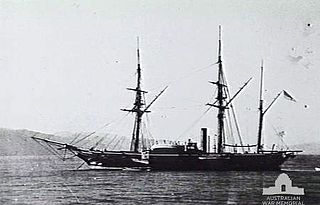
HMS Virago was a Royal Navy Driver-class wooden paddle sloop launched on 25 July 1842 from Chatham Dockyard.

HMS Penguin was an Osprey-class sloop. Launched in 1876, Penguin was operated by the Royal Navy from 1877 to 1881, then from 1886 to 1889. After being converted to a survey vessel, Penguin was recommissioned in 1890, and operated until 1908, when she was demasted and transferred to the Australian Commonwealth Naval Forces for use as a depot and training ship in Sydney Harbour. After this force became the Royal Australian Navy, the sloop was commissioned as HMAS Penguin in 1913. Penguin remained in naval service until 1924, when she was sold off and converted into a floating crane. The vessel survived until 1960, when she was broken up and burnt.

HMS Raven was a Banterer-class gunboat of the Royal Navy, built by Samuda Brothers of Poplar, London, and launched on 18 May 1882. She served on the Australia Station and was converted to a diving tender in 1904. After being lent as a training ship in 1913 she was sold for breaking in 1925.
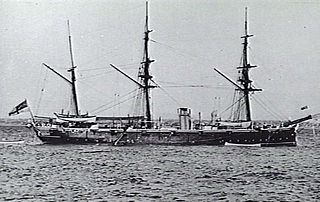
HMS Pylades was a Satellite-class composite screw sloop of the Royal Navy, built at Sheerness Dockyard and launched on 5 November 1884. She was later reclassified as a corvette and was the last corvette built for the Royal Navy until the Second World War.

HMS Rapid was a Satellite-class composite screw sloop of the Royal Navy, built at Devonport Dockyard and launched on 21 March 1883. She was later reclassified as a corvette.

HMS Torch was an Alert-class sloop of the Royal Navy, built at Sheerness Dockyard and launched in 1894. She served in Australia and New Zealand and was transferred to New Zealand as a training ship in 1917, being renamed HMS Firebrand at the same time. She was sold in 1920 and converted to a refrigerated ship with the new name Rama. She ran aground in the Chatham Islands in 1924 and was abandoned.

HMS Diamond was an Amethyst-class corvette in service 1874–89.
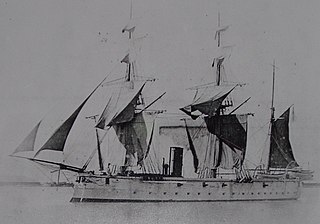
HMS Nymphe was an Amazon-class sloop, of the Royal Navy, built at the Deptford Dockyard and launched on 24 November 1866. She served in the East Indies and Australia, and was sold in 1884.
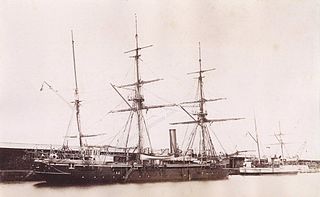
HMS Rambler was an Algerine-class gunvessel of the Royal Navy, built by John Elder & Co., Glasgow and launched on 26 January 1880. She was commissioned as a survey vessel in 1884 and served in Chinese waters during the 1880s and 1890s. She provided men to a naval brigade during the Boer War and was sold on 23 January 1907. The work of this vessel is now remembered in Hong Kong by the Rambler Channel near Tsing Yi.

HMS Ringdove was a Redbreast-class gunboat of the Royal Navy, built at Devonport Dockyard and launched on 30 April 1889.

HMS Lizard was a Bramble-class screw gunboat of the Royal Navy, built by Harland & Wolff, Belfast and launched on 27 November 1886.

HMS Phoebe was a Pearl-class cruiser of the Royal Navy, in service from the early 1890s until 1906.

HMS Mutine was a Condor-class sloop of the Royal Navy. Mutine was launched on 1 March 1900. While being delivered from Birkenhead to Portsmouth an accident in Mutine's boiler rooms caused some loss of life and gave her a name as an unlucky ship before her career even began. She served on the China Station, then the Australia Station between December 1903 and February 1905 and later became a survey ship, surviving until 1932 as a Royal Naval Volunteer Reserve drill ship, the last of her class to be sold.
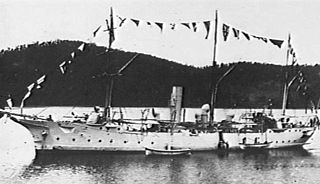
HMS Cadmus was a Cadmus-class sloop of the Royal Navy. She was launched at Sheerness in 1903, spent her entire career in the Far East and was sold at Hong Kong in 1921.





















